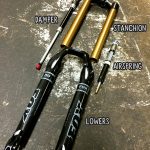Just like a fork, a rear shock has two key elements: a spring (either coil or air) and a damper. Remember, the spring gives your shock its resisting force (squish) and the damper regulates how quickly that spring compresses (squishes) and rebounds (un-squishes, extends). A major difference between a fork and shock is that usually* in a fork, the spring components are in one stanchion and the damping components are in the other. Because space is a luxury that the rear shock lacks, the damper is usually encapsulated by the spring.
To kick things off, check out this overview of a common air shock (Fox Float), fully dissected.
Air springs are most common on XC, trail, and all-mountain bikes due to their lighter weight and ease of adjustment (i.e. the ability to easily adjust spring weight for efficiency and feel in variable conditions). Coil springs, on the other hand, are most popular among the DH crowd—where efficiency is less of an issue—because of their unmatched small bump sensitivity and bomb-proof durability.
Damper Parts
A shock damper body (sometimes referred to as a stanchion on air shocks) serves two purposes. First, the external surface of the damper body acts as the sealing surface for the gas contained in air spring, which is why it is very important to keep this area clean and scratch-free. Second, the damper body internally houses your damper fluid, which is the medium that allows for control of the compression and rebound characteristics.
Here is a breakdown of what goes on inside a shock damper body.
- Seal Head: The seal head threads onto the damper body, which encloses your damper system and its associated fluid.
- Piston: As your shock compresses and rebounds, the piston moves through the damper fluid. The damping characteristics are controlled by opening or closing ports within the piston, allowing the fluid to flow more or less freely.
- Internal Floating Piston (IFP): The IFP is a moving barrier that separates your nitrogen charge and damper fluid. A nitrogen charge can be as high as 500 PSI
These components allow a shock to literally “put a damper” on what would otherwise be an out of control spring and allow for rear wheel traction through the rough stuff. Depending on the type of shock a user can manipulate different performance characteristics of the damper using the controls:
- Compression Controls: These controls adjust a shock’s compression damping rate. The type of controls and amount of adjustment available vary greatly based on brand, architecture of the shock and tune applied. The bottom line is that adding more compression damping firms up the shock, which is useful for pedaling efficiency and for riders who prefer a more supportive feel.
- Rebound Controls: Usually present in the form of a red dial or knob, the rebound control allows adjustment of the rate of rebound damping (adding rebound damping slows the shock down while subtracting it lets the shock rebound more quickly). The location of the control and the range of adjustment varies greatly from shock-to-shock.
Air spring Parts
Shock air springs are canisters, which have two chambers, a positive and a negative. They come in many different shapes and sizes, the different design characteristics influence the spring rate and performance of the shock. The air can threads directly into the head of the shock (the part that contains the controls and valve stem), forming the air system’s upper seal.
- Positive Chamber: This is the area inside of an air can that is pressurized with a shock pump. The pressure in the positive chamber is the primary force to provide support the weight of the rider and insulate the rider from the trail. As your rear wheel moves through its travel, the seal head glides up the piston shaft and compresses the air in the positive chamber, creating the spring effect.
- Negative Chamber: The seal head isolates the negative chamber from the positive chamber. While the air in the positive chamber works to keep the shock extended, the air in the negative chamber pushes gently in the opposite direction, helping to provide a consistent spring weight and balanced feel. The negative chamber assists in initial stroke, small bump compliance and top-out resistance. In recent years, an emphasis has been placed on enlarging the negative air chamber to allow for more small bump compliance and a more linear spring rate. (Check out the enlarged negative chamber on new Fox EVOL air can pictured above.)
Other Bits and Pieces
- Eyelets are the mounting points located at the top and bottom of the shock.
- DU bushings (both old and new styles pictured) are the wearable components that keep your shock’s mounting hardware snug in the eyelets.
- Mounting hardware is frame specific (with almost 50 “standard sizes”) and fills the space between your frame mounting points and the shock itself.
- The valve stem protrudes from the head of the shock and serves as the point at which air is added to or removed from the shock.
- The dust wiper helps keep dust out of your air canister, which is crucial to your shock’s performance. Dust = friction/stiction and wear on internal seals. Pressed into the base of the air can, it hugs your shock’s damper body snugly and skims dust and grime off as your shock compresses.
- Sag ring: This simple o-ring hangs out on the damper body, letting you know how much sag you’re running and if you’re using all of your travel or not.




